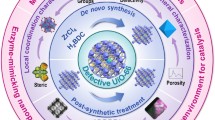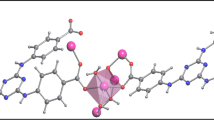Abstract
Two novel hexa-nickel(II)-substituted Keggin-type {Ni6PW9}-based tungstophosphates [Ni6(μ 3-Tris)(en)3(Pr)(damp)(H2O)2(B-α-PW9O34)]·10H2O (1) and [Ni6(μ 3-Tris)(en)3(damp)2(H2O)2(B-α-PW9O34)]·7H2O (2) (en = ethylenediamine, Pr = CH3CH2COO−, damp = 2-aminoisobutyrate, Tris = pentaerythritol) were hydrothermally synthesized and characterized by IR spectra, elemental analyses, powder X-ray diffraction, thermogravimetric analyses, and single-crystal X-ray diffraction. Crystal data for 1: orthorhombic, Pca21, a = 21.6962(7) Å, b = 20.6398(5) Å, c = 14.7825(4) Å, β = 90º, V = 6619.7(3) Å3, Z = 4; for 2: orthorhombic, Pca21, a = 21.6978(9) Å, b = 20.6658(7) Å, c = 14.7767(4) Å, β = 90º, V = 6625.9(4) Å3, Z = 4. 1 consists of a {Ni6(μ 3-Tris)(en)3(Pr)(damp)(H2O)2}9+ core and a [B-α-PW9O34]9− (PW9) unit and is covalently functionalized by one Pr and one damp, as well as en and Tris ligands. The structure of 2 is the same to 1 except that the Pr anion in 1 is substituted by the other damp ligand. Most interestingly, 1 contains four kinds of organic ligands, while 2 includes three kinds of organic ligands, which are first observed in polyoxometalate chemistry.








Similar content being viewed by others
References
S.-T. Zheng and G.-Y. Yang (2012). Chem. Soc. Rev. 41, 7623.
A. Proust, B. Matt, R. Villanneau, G. Guillemot, P. Gouzerha, and G. Izzeta (2012). Chem. Soc. Rev. 41, 7605.
O. Oms, A. Dolbecq, and P. Mialane (2012). Chem. Soc. Rev. 41, 7497.
A. Sartorel, M. Bonchio, S. Campagnab, and F. Scandola (2013). Chem. Soc. Rev. 42, 2262.
L. Chen, D. Shi, J. Zhao, Y. Wang, P. Ma, J. Wang, and J. Niu (2011). Cryst. Growth Des. 11, 1913.
S.-T. Zheng, D.-Q. Yuan, H.-P. Jia, J. Zhang, and G.-Y. Yang (2007). Chem. Commun. 43, 1858.
J.-W. Zhao, C.-M. Wang, J. Zhang, S.-T. Zheng, Z.-H. Li, and G.-Y. Yang (2008). Chem. Eur. J. 14, 9223.
L.-J. Chen, J.-W. Zhao, P.-T. Ma, Q.-X. Han, J.-P. Wang, and J.-Y. Niu (2010). Inorg. Chem. Commun. 13, 50.
J.-W. Zhao, D.-Y. Shi, L.-J. Chen, P.-T. Ma, J.-P. Wang, and J.-Y. Niu (2011). Cryst. Eng. Comm. 13, 3462.
S.-T. Zheng, J. Zhang, and G.-Y. Yang (2008). Angew. Chem. Int. Ed. 47, 3909.
J.-W. Zhao, S.-T. Zheng, Z.-H. Li, and G.-Y. Yang (2009). Dalton Trans. 38, 1300.
H. El Moll, A. Dolbecq, J. Marrot, G. Rousseau, M. Haouas, F. Taulelle, G. Rogez, W. Wernsdorfer, B. Keita, and P. Mialane (2012). Chem. Eur. J. 18, 3845.
B. Nohra, P. Mialane, A. Dolbecq, E. Rivière, J. Marrot, and F. Sécheresse (2009). Chem. Commun. 45, 2703.
J.-W. Zhao, H.-P. Jia, J. Zhang, S.-T. Zheng, and G.-Y. Yang (2007). Chem. Eur. J. 14, 10030.
S.-T. Zheng, J. Zhang, and G.-Y. Yang (2008). Angew. Chem. Int. Ed. 47, 3909.
S.-T. Zheng, J. Zhang, J. M. Clemente-Juan, D.-Q. Yuan, and G.-Y. Yang (2009). Angew. Chem. Int. Ed. 48, 7176.
S.-T. Zheng, J. Zhang, and G.-Y. Yang (2010). J. Am. Chem. Soc. 132, 15102.
X–. X. Li, S.-T. Zheng, W.-H. Fang, and G.-Y. Yang (2011). Inorg. Chem. Commun. 14, 1541.
X.–. X. Li, S.-T. Zheng, J. Zhang, W.-H. Fang, G.-Y. Yang, and J. M. Clemente-Juan (2011). Chem. Eur. J. 17, 13032.
L. Huang, J. Zhang, L. Cheng, and G.-Y. Yang (2012). Chem. Commun. 48, 9658.
W. L. Chen, Y. G. Li, Y. Wang, E. B. Wang, and Z. M. Su (2007). Dalton Trans. 36, 4293.
M. H. Alizadeh, M. Mirzaei, A. R. Salimi, and H. Razavi (2009). Mater. Res. Bull. 44, 1515.
H. Eshtiagh-Hosseini and M. Mirzaei (2012). J. Cluster Sci. 23, 345.
H. Y. An, E. B. Wang, D. R. Xiao, Y. G. Li, Z. M. Su, and L. Xu (2006). Angew. Chem. Int. Ed. 45, 904.
J. Liu, Y. G. Li, E. B. Wang, D. R. Xiao, L. L. Fan, Z. M. Zhang, and Y. Wang (2007). J. Mol. Struct. 837, 237.
H. Y. An, E. B. Wang, Y. G. Li, Z. M. Zhang, and L. Xu (2007). Inorg. Chem. Commun. 10, 299.
C. Ritchie, M. Speldrich, R. W. Gable, L. Sorace, P. Kogerler, and C. Boskovic (2011). Inorg. Chem. 50, 7004.
C. Ritchie and C. Boskovic (2010). Cryst. Growth Des. 10, 488.
H. Naruke, J. Iijjima, and T. Sanji (2011). Inorg. Chem. 50, 7535.
J. Iijjima, H. Naruke, and T. Sanji (2012). Chem. Lett. 41, 295.
G. Rousseau, O. Oms, A. Dolbecq, J. Marrot, and P. Mialane (2011). Inorg. Chem. 50, 7376.
Y.-H. Wang, C.-W. Hu, E.-B. Wang, N.-H. Hu, H.-Q. Jia, and Y. Xing (2001). Chem. J. Chin. Uni. 22, 362.
Y–. Y. Zheng, R. Wen, X.-J. Kong, L.-S. Long, R.-B. Hunag, and L.-S. Zheng (2012). Dalton Trans. 41, 9871.
P. J. Domaille (1990). Inorg. Synth. 27, 100.
Agilent CrysAlis PRO (Agilent Technologies, Yarnton, Oxfordshire, 2011).
G. M. Sheldrick SADABS, Program for Siemens Area Detector Absorption Corrections (University of Göttingen, Göttingen, 1997).
G. M. Sheldrick SHELXS 97, Program for Crystal Structure Solution (University of Göttingen, Göttingen, 1997).
G. M. Sheldrick SHELXS 97, Program for Crystal Structure Refinement (University of Göttingen, Göttingen, 1997).
Acknowledgments
This work was supported by the NNSF of China (nos. 91122028, 21221001, 50872133, 21101055, 21301049 and U1304208), the NNSF for Distinguished Young Scholars of China (no. 20725101), and the 973 program (nos. 2014CB932101 and 2011CB932504).
Author information
Authors and Affiliations
Corresponding authors
Rights and permissions
About this article
Cite this article
Cai, B., Yang, BF., He, H. et al. Amino Acid Functionalization of {Ni6PW9}-Based Clusters Under Hydrothermal Conditions. J Clust Sci 25, 1283–1293 (2014). https://doi.org/10.1007/s10876-014-0706-4
Received:
Published:
Issue Date:
DOI: https://doi.org/10.1007/s10876-014-0706-4




